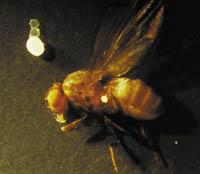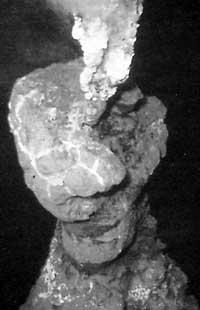Giant bacteria of Namibia
1999/05/23 Kortabarria Olabarria, Beñardo - Elhuyar Zientzia
A team of researchers from Germany, Spain and the United States, working on the coast of Namibia, has discovered and baptized the largest known bacteria so far. Thiomargarita namibiensis, that is, the Pearl of the Sulfur of Namibia. This microorganism can be visually seen, it is 100 times greater than the largest microorganisms known so far, as the dot we will put at the end of this sentence.
"When I learned about the discovery, my colleagues didn't want to believe me because the bacteria were too big." The phrase is from Heide Schulz, a Marine Microbiology student at the Max Planck Institute. In fact, it was he who discovered among the sediment samples collected by ships using giant bacteria for research. "As I have worked with rare bacteria, I immediately realized it was sulfur bacteria."

In addition to its enormous size, the bacterium Thiomargarita is an exotic microorganism that can serve as an axis to understand two processes that take place in the oceans (the sulfur cycle on the one hand and the nitrogen cycle on the other) and their relationship. Until now, scientists considered that both processes were incompatible with each other. These microorganisms store the basic sulfur inside the bacterial wall, not only for being able to collect blue-greenish luster nitrate. They also grow in chain. That is why scientists compare them with perlite in a row. The diameter of these cells can be around 3/4 of the millimeter. Perhaps with an example you can better understand. Suppose the Thiomargarita bacteria turned it into a blue whale, specifically, against which the common bacteria would have the same size as mice. The biggest bacteria known until the appearance of this news would be the Epulopiscum fishelsoni, in this example, the size of lions.
Sulphur and nitrate bridge
We spoke casually in the first lines of the article. In fact, researchers working in Namibia were looking for two other sulfur bacteria: Beggiato and Thioploca. These bacteria were studied in the Pacific Ocean, but as the hydrography of the coast of Namibia is very similar, it was also intended to locate and study them there. There scientists were surprised by the small number of bacteria. The surprise was even greater when they met Thiomargarita. This bacterium faces a great ecological challenge: the oxidation of sulphides with the help of nitrates. Sea water is rich in nitrates, but it does not reach the poor, oxygen-rich sediments, which are bacteria.
"Bacteria can live, as Schulz says, because they are able to collect sulfur and nitrate at the same time. This demonstrates the relationship between sulfur and nitrate cycles." This link can be of great importance in understanding the origin and characteristics of life. The terrestrial environment, and therefore life, needs to continually recycle certain basic elements such as carbon, nitrogen and sulfur. Microorganisms are able to develop chemical reactions of great importance, such as oxidation and reduction, so they are the beings most involved in these cycles. These reactions can produce these elements in the oceans, sediments, atmosphere and living beings.
The bacteria found bridge the sulfur and nitrogen cycles. Considering the abundance of sulphides in the place where bacteria have been found, in the abundant plankton, researchers have raised the doubt that the oxidation of bacteria will not be more important to the environment than previously thought.
A future without microscopy?
Because Thiomargarita bacteria have no mobility, it is found in the water sediment collecting sulfur until it meets nitrate. Not being able to move, this bacteria is forced to suffer long fasting without major problems. Compared to other bacteria, these giants are characterized by being able to adapt to high concentrations of oxygen and sulfur.
Given all the features mentioned, it is not surprising that in later years these bacteria carry most of the daily work of many researchers. Scientists will lose glamour because they won't have to use microscopy.
Published in 7K

Gai honi buruzko eduki gehiago
Elhuyarrek garatutako teknologia





